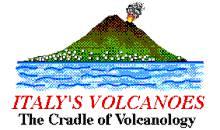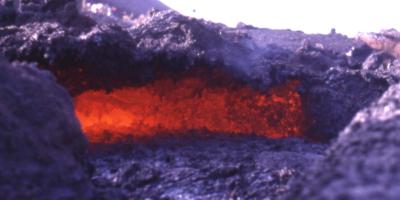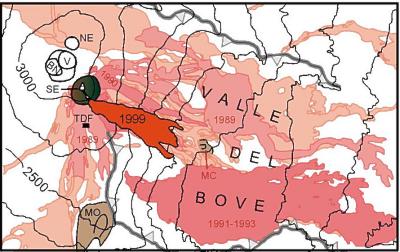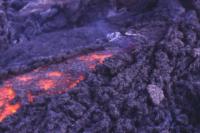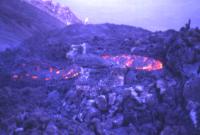|
Archived Etna news
|
Do you plan to visit Etna
in the near future?
Check the weather
forecasts for the Etnean area!
Looking into the mouth
of an effusive vent near the hornitos at the southeastern base of the
SE Cone, 10 June 1999
Sketch map of the
Valle del Bove and area of the lava flow-field emplaced since 4 February
1999.
The
lavas erupted during the period 1989-1993 are shown in various shades
of pink, previous flows (since 1971) are shown in brighter color. 1995
to early 1999 lavas are not shown. NE=NE Crater; V=Voragine; BN=Bocca
Nuova; SE=SE Cone; TDF=Torre del Filosofo; MO=Montagnola; RS=Rifugio
Sapienza (only in large version of the map); MC=Monti Centenari. The
large version of this map shows a larger area, a scale bar and an index
map.
|
WARNING: Access to the summit craters can be DANGEROUS. Weather conditions are often unstable, and there is always a risk of sudden explosive activity from the summit craters. As effusive activity from the fissure near the southeastern base of the SE Cone is gradually decreasing, renewed activity may be expected from the craters soon after the cessation of the lava outflow. Any person who enters the area beyond the Torre del Filosofo mountain hut (2900 m elevation) goes at his/her own risk and is not covered by any insurance in case a rescue operation (e.g., with helicopters) is necessary. The same is true for those who try to get close to the still-active effusive vents on the Valle del Bove slope. |
A brief visit was made on the late afternoon of 10 June to the active effusive vents near the SE Cone by Boris Behncke and Francesca Ghisetti of the Istituto di Geologia e Geofisica of Catania University (IGGUC). Since Behncke's previous visit on 4 June, the output of lava from the 4 February eruptive fissure has increased notably while only one ephemeral vent continues to emit lava on the western Valle del Bove slope. The active vents on the 4 February fissure are located only about 10-20 m below the hornitos at the upper end of the fissure, and effusive activity has shifted tens of meters upslope during the past 4 weeks.
While there was one vigorous effusive vent located right on the fissure, lava also issued from numerous places within and on the margins of recent flows which have accumulated on the southwestern side of the lava field emplaced since 4 February. A well-fed flow moved down the northern side of that lava field and appears to have spilled over the rim of Valle del Bove to the north of the previously emplaced lavas. Dust clouds generated by rockfalls and bluish fumes indicated lava moving in that area which was not accessible. The ephemeral vent on the western Valle del Bove slope, in the area of the tumulus collapsed on 19 May emitted a sluggish flow that advanced only a few meters downslope, and there was no effusive activity elsewhere in that area. This indicates that supply to its feeder tube is much reduced, probably causing the increased surface lava emission below the hornitos.
visitors counted since 12 February 1999
(more than 10,000 during the first 3 weeks!)
FastCounter
by LinkExchange
Page set up on 27 May 1997, last modified on 18 June 1999
